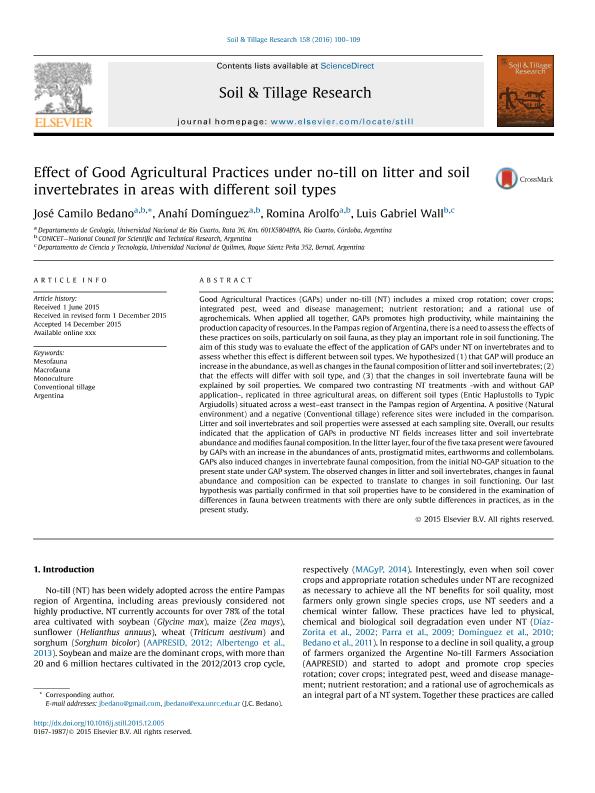Artículo
Effect of Good Agricultural Practices under no-till on litter and soil invertebrates in areas with different soil types
Fecha de publicación:
01/2016
Editorial:
Elsevier Science
Revista:
Soil & Tillage Research
ISSN:
0167-1987
Idioma:
Inglés
Tipo de recurso:
Artículo publicado
Clasificación temática:
Resumen
Good Agricultural Practices (GAPs) under no-till (NT) includes a mixed crop rotation; cover crops; integrated pest, weed and disease management; nutrient restoration; and a rational use ofagrochemicals. When applied all together, GAPs promotes high productivity, while maintaining theproduction capacity of resources. In the Pampas region of Argentina, there is a need to assess the effects of these practices on soils, particularly on soil fauna, as they play an important role in soil functioning. The aim of this study was to evaluate the effect of the application of GAPs under NT on invertebrates and to assess whether this effect is different between soil types. We hypothesized (1) that GAP will produce an increase in the abundance, as well as changes in the faunal composition of litter and soil invertebrates; (2) that the effects will differ with soil type, and (3) that the changes in soil invertebrate fauna will be explained by soil properties. We compared two contrasting NT treatments -with and without GAP application-, replicated in three agricultural areas, on different soil types (Entic Haplustolls to Typic Argiudolls) situated across a west?east transect in the Pampas region of Argentina. A positive (Natural environment) and a negative (Conventional tillage) reference sites were included in the comparison. Litter and soil invertebrates and soil properties were assessed at each sampling site. Overall, our results indicated that the application of GAPs in productive NT fields increases litter and soil invertebrate abundance and modifies faunal composition. In the litter layer, four of the five taxa present were favouredby GAPs with an increase in the abundances of ants, prostigmatid mites, earthworms and collembolans. GAPs also induced changes in invertebrate faunal composition, from the initial NO-GAP situation to the present state under GAP system. The observed changes in litter and soil invertebrates, changes in faunal abundance and composition can be expected to translate to changes in soil functioning. Our last hypothesis was partially confirmed in that soil properties have to be considered in the examination of differences in fauna between treatments with there are only subtle differences in practices, as in the present study
Palabras clave:
MESOFAUNA
,
MACROFAUNA
,
MONOCULTURE
,
CONVENTIONAL TILLAGE
,
ARGENTINA
Archivos asociados
Licencia
Identificadores
Colecciones
Articulos(CCT - CORDOBA)
Articulos de CTRO.CIENTIFICO TECNOL.CONICET - CORDOBA
Articulos de CTRO.CIENTIFICO TECNOL.CONICET - CORDOBA
Articulos(SEDE CENTRAL)
Articulos de SEDE CENTRAL
Articulos de SEDE CENTRAL
Citación
Bedano, José Camilo; Domínguez, Anahí; Arolfo, Romina Vanesa; Wall, Luis Gabriel; Effect of Good Agricultural Practices under no-till on litter and soil invertebrates in areas with different soil types; Elsevier Science; Soil & Tillage Research; 158; 1-2016; 100-109
Compartir
Altmétricas




